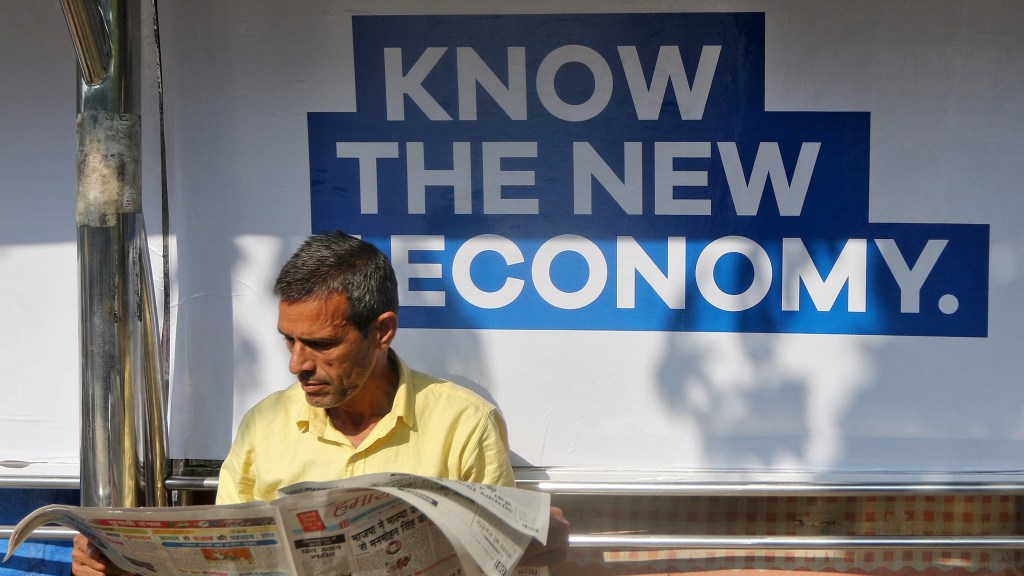By Bibek Debroy,
The expression “Viksit Bharat” figured in the Interim Budget speech. It has appeared in other places too. There is always a problem in transcribing Sanskrit words into English, if diacritical marks or IAST (International Alphabet of Sanskrit Transliteration) aren’t used. Which “sha” do we mean, “sha” ( ) or “sa” ( )? “Vi” is just a qualifier, called upasarga. If we intend to use “sha”, the associated verbal root is “to shine”. “Viksit Bharat” is “India Shining”, reminiscent of a slogan from a different era.
If we intend to use “sa”, the associated verbal root is “to move or go”. “Vikasita” means bloomed, blossomed, opened, grown, or developed. National Development Council is Rashtriya Vikas Parishad. Hence, as is obvious to everyone, “Viksit Bharat” is to be understood in the sense of a developed India, an aspirational goal for 2047.
This is the way it was articulated by the Prime Minister in his 77th Independence Day speech on August 15, 2023. “In every aspect of progress, when we move forward with the dream of a developed India by 2047, it’s not just a dream but a resolve of 1.4 billion citizens….Friends, my dear family members, I have an unwavering belief that in 2047, when the country celebrates 100 years of independence, my country will be a developed India.”
With that understood, what does the expression “developed” mean and what metric do we use to pin it down? Otherwise, like a parable concerning blind men and an elephant, used by Adi Shankaracharya in his commentary on the Chandogya Upanishad, we will be talking at cross purposes. That parable was probably made more famous by a John Godfrey Saxe poem.
In said poem, the six learned men respectively compared an elephant to a wall, a spear, a snake, a tree, a fan, and a rope. For “developed”, we may not have six different criteria. But per capita GDP (income), level of industrialisation, importance of service sector, and HDI (human development index) are all plausible options. Despite developmental indicators often being correlated with one another, such differing criteria might not lead to the same identification. To quote a line from the Saxe poem, “Though each was partly in the right, And all were in the wrong!”
There was a time when the world economy was simpler and notions of development were relatively straightforward. The world was divided into developed countries as “haves”, developing countries (under-developed countries) as “have-nots” and LDCs (least developed countries) as “never-haves”.
With more than 190 countries in the world, economies that are diverse and heterogenous, it is doubtful if anything is gained by fitting all these into three neat straitjackets. (Think of finer differences like land-locked and small island economies.) To borrow a word that originally comes from Scotland, this is plain “haverel”.
At best, one can make an exception for LDCs because of special and differential treatment. That’s the reason UNCTAD has a list of 45 LDCs, which is the one used by WTO for those that are WTO members. This is a physical listing, which does not explain details of variables that go into identification. The developed versus developing dichotomy is weaker.
To quote UNCTAD, “All target economies are also categorized into developing or developed economies. This categorization is based on a distinction between developing and developed regions that was commonly used in the past and is maintained by UNSD (United Nations Statistical Division) with the understanding that being part of either developed or developing region is through sovereign decision of a state.
The developing economies broadly comprise Africa, Latin America and the Caribbean, Asia without Israel, Japan, and the Republic of Korea, and Oceania without Australia and New Zealand. The developed economies broadly comprise Northern America and Europe, Israel, Japan, the Republic of Korea, Australia, and New Zealand.”
A sovereign decision by a State of course robs the definition of all objectivity, and if definition is geography-driven, as stated by UNCTAD, given the areas listed, India can never be a developed nation.
The notion of a “developed economy”, as contrasted with a “developing economy”, does not exist any longer. To quote the UN, other than UNCTAD, “There is no definition of developing and developed countries (or areas) within the UN system… Over time the use of the distinction between “Developed regions” and “Developing regions”, including in the flagship publications of the United Nations, has diminished.”
The World Bank no longer uses terms like “developed” and “developing”. Instead, the categories are low-income, lower-middle income, upper-middle income, and high-income. Low-income is for per capita income less than $1,085, lower-middle income for per capita income between $1,086 and $4,255, higher-middle income for per capita income between $4,256 and $13,205, and high-income is for per capita income more than $13,205.
For cross-country comparisons, conversion to a common numeraire like the US dollar is required. Conversions of the rupee to a US dollar number can be done using the official exchange rate (the so-called Atlas method) or PPP (purchasing power parity) exchange rates. World Bank’s categories are based on official exchange rates. With official exchange rates, India is in the lower-middle income category now.
Thus, here are the options to pin down India in 2047. First, an HDI more than 0.800 can be aimed for. Second, a movement to high-income category in constant US dollars can be considered. Third, a movement to high-income category in current (2047) US dollars is viable. We usually intend the second or the third, and understandably, the third is easier to reach than the second.
(The author is Chairman, EAC-PM)

